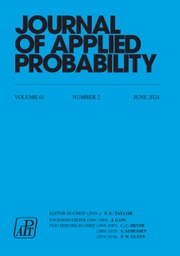Crossref Citations
This article has been cited by the following publications. This list is generated based on data provided by Crossref.
Horvath, Blanka
Jacquier, Antoine
and
Lacombe, Chloe
2017.
Asymptotic Behaviour of Randomised Fractional Volatility Models.
SSRN Electronic Journal,
Horvath, Blanka
Jacquier, Antoine
and
Muguruza, Aitor
2017.
Functional Central Limit Theorems for Rough Volatility.
SSRN Electronic Journal,
Jacquier, Antoine
and
Roome, Patrick
2018.
Black–Scholes in a CEV random environment.
Mathematics and Financial Economics,
Vol. 12,
Issue. 3,
p.
445.
Lacombe, Chloe
Muguruza, Aitor
and
Stone, Henry
2019.
Asymptotics for Volatility Derivatives in Multi-Factor Rough Volatility Models.
SSRN Electronic Journal ,
Morelli, Giacomo
and
Santucci de Magistris, Paolo
2019.
Volatility tail risk under fractionality.
Journal of Banking & Finance,
Vol. 108,
Issue. ,
p.
105654.
Stone, Henry
2019.
Calibrating Rough Volatility Models: A Convolutional Neural Network Approach.
SSRN Electronic Journal ,
Horvath, Blanka
Jacquier, Antoine
and
Lacombe, Chloé
2019.
Asymptotic behaviour of randomised fractional volatility models.
Journal of Applied Probability,
Vol. 56,
Issue. 2,
p.
496.
Horvath, Blanka
Muguruza, Aitor
and
Tomas, Mehdi
2019.
Deep Learning Volatility.
SSRN Electronic Journal ,
Bayer, Christian
Friz, Peter K.
Gassiat, Paul
Martin, Jorg
and
Stemper, Benjamin
2020.
A regularity structure for rough volatility.
Mathematical Finance,
Vol. 30,
Issue. 3,
p.
782.
Bayer, Christian
Ben Hammouda, Chiheb
and
Tempone, Raúl
2020.
Hierarchical adaptive sparse grids and quasi-Monte Carlo for option pricing under the rough Bergomi model.
Quantitative Finance,
Vol. 20,
Issue. 9,
p.
1457.
Gulisashvili, Archil
2020.
Time-Inhomogeneous Gaussian Stochastic Volatility Models: Large Deviations and Super Roughness.
SSRN Electronic Journal ,
Stone, Henry
2020.
Calibrating rough volatility models: a convolutional neural network approach.
Quantitative Finance,
Vol. 20,
Issue. 3,
p.
379.
Gerhold, Stefan
Jacquier, Antoine
Pakkanen, Mikko
Stone, Henry
and
Wagenhofer, Thomas
2021.
Pathwise large deviations for the rough Bergomi model: Corrigendum.
Journal of Applied Probability,
Vol. 58,
Issue. 3,
p.
849.
Friz, P. K.
Gassiat, P.
and
Pigato, P.
2021.
Precise asymptotics: Robust stochastic volatility models.
The Annals of Applied Probability,
Vol. 31,
Issue. 2,
Lacombe, Chloe
Muguruza, Aitor
and
Stone, Henry
2021.
Asymptotics for volatility derivatives in multi-factor rough volatility models.
Mathematics and Financial Economics,
Vol. 15,
Issue. 3,
p.
545.
Horvath, Blanka
Muguruza, Aitor
and
Tomas, Mehdi
2021.
Deep learning volatility: a deep neural network perspective on pricing and calibration in (rough) volatility models.
Quantitative Finance,
Vol. 21,
Issue. 1,
p.
11.
Gulisashvili, Archil
2021.
Time-inhomogeneous Gaussian stochastic volatility models: Large deviations and super roughness.
Stochastic Processes and their Applications,
Vol. 139,
Issue. ,
p.
37.
Fukasawa, Masaaki
2021.
Volatility has to be rough.
Quantitative Finance,
Vol. 21,
Issue. 1,
p.
1.
Yang, Yongxin
and
Hospedales, Timothy M.
2022.
On Calibration of Mathematical Finance Models by Hypernetworks.
SSRN Electronic Journal,
Hager, Paul
and
Neuman, Eyal
2022.
The multiplicative chaos of H=0 fractional Brownian fields.
The Annals of Applied Probability,
Vol. 32,
Issue. 3,

